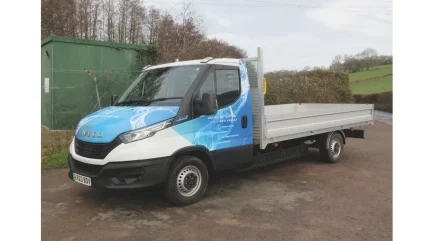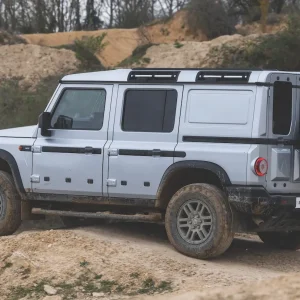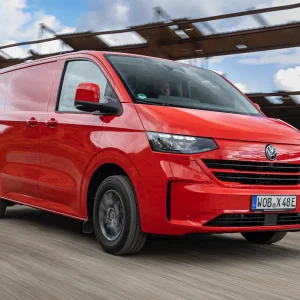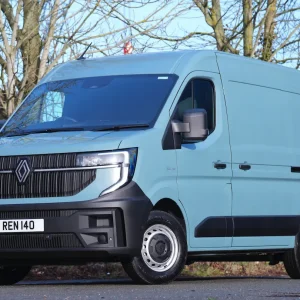
Iveco is determined to boost its share of the zero-emission commercial vehicle market with the all-electric eDaily.
Debuting in the UK last year, the eDaily line-up encompasses vans, chassis cabs and crew cabs grossing at from 3.5t to 7.2t. Customers can select models with one, two, three or four battery packs delivering 37kWh, 74kWh, 111kWh and 148kWh respectively; a remarkably comprehensive line-up.
Batteries can be added or subtracted during the eDaily’s working life if the operator’s requirements change. The exercise takes around two hours.
Remove a battery and you increase your carrying capacity by 270kg.
Power comes courtesy of a 140kW motor. However it is worth noting that this drops to 100kW if you specify a single battery pack.
Businesses eager to maximise payload capacity should be aware that the 4.25t eDaily 42S can be driven on a car driver’s licence as a concession to its zero-emission status. Ordinarily drivers who passed their car driver’s test after 1 January 1997 have to pass a separate test if they want to drive anything heavier than 3.5t.
Bear in mind though that if you want to take advantage of the 4.25t concession then you will have to undergo five hours of special training.
It could be worth it. Opt for two batteries on a 3.5t eDaily van and your maximum gross payload is a modest 1,100kg. Opt for three on a 4.25t and your maximum shoots up to 1,415kg; so one can appreciate the model’s appeal.
Cargo space is unlikely to be an issue with eDaily. Maximum van load volume is an echoing 19.6m3.
We decided to make Herefordshire a cleaner, greener place by taking charge of a 3.5t 35S14E single-rear-wheel eDaily chassis cab with a 4,100mm wheelbase and fitted with a dropside body. It came with two battery packs so we had 74kWh to play with, with 70kW of usable energy.
Here’s how we fared.
Load bay
Built by Brit-Tipp, the eDaily’s dropside body comes with a timber floor and features alloy sides and an alloy tailboard, all of which are simple to release and drop down. A fold-down step on the inside of the nearside drop-down side plus a grab handle on the bulkhead make it easy to climb up onto the load bed when the side is folded down.
The bulkhead is solid with a mesh upper section and is there to protect the back of the cab if the load slides forward as a result of heavy braking. However, the way in which the body is designed makes it easy to lash down cargo securely.
Reflectors are mounted on the inside of the tailboard to make it easier for other drivers to spot the vehicle if it is being loaded or unloaded by the roadside at night. The body is covered by Brit-Tipp’s three-year/unlimited-mileage warranty and the body package included the two cab-roof-top lights fitted to our vehicle.
Interior and equipment
A DAB radio is included in the Bluetooth-enabled specification as is a touchscreen that among other things can tell you the level of charge left in the battery and the remaining range. The charge level is also displayed on the instrument panel.
Electric windows, heated and electrically adjustable exterior mirrors with a lower wide-angle section, and an electric parking brake are all included in the deal. A rear-view camera was fitted to our test vehicle, but wasn’t working.
A variety of standard and optional connectivity-enabled services are provided with eDaily through the Iveco On portal, with software updates enabled over the air and predictive diagnostics hopefully preventing faults leading to unscheduled halts. The services include the eDaily Routing app, which predicts the vehicle’s range, how much charge will be required for it to reach its destination, and the time of arrival.
The three-seater cab is not short of storage facilities.
The roster includes two lidded compartments plus a tray with a couple of USB sockets on the top of the dashboard, a capacious glovebox with a shelf above it, and two more shelves below the chunky, user-friendly, heating and ventilation switches. Our demonstrator came with automatic climate control.
Big bins in each of the doors include a moulding that can grasp a flask or a bottle of water and you will find a cup holder at each extremity of the fascia.
The back of the middle seat optionally folds down and turns into a desk with a detachable clipboard to keep paperwork tidy; we cannot help but remark that some items that are standard on competitor vehicles are options on eDaily. Pull up the passenger seat cushions, and you will find concealed compartments; handy for stowing away the vehicle’s charging cables.
The driver’s seat is height-adjustable as is the steering wheel, which plays host to the switches for the adaptive cruise control system. With its own, optional, suspension system plus an armrest and lumbar adjustment, and featuring memory foam, the seat is remarkably comfortable.
Driver and passenger airbags are fitted if you specify them as an option, and the wipers are triggered when rain spatters the optionally heated windscreen.
Front fog lights should prove useful in murky weather.
On-board driver assistance and safety systems include Hill Descent Control.
Advanced Electronic Braking System and City Brake should help minimise the risk of collisions if you take them as an option, as should Lane Departure Warning and Lane Keeping Assist.
In its latest iteration, the eDaily boasts a 10.25in digital instrument cluster. It comes with either a 7in or a 10in touchscreen with satnav, smartphone mirroring and voice control for the lights, windows and climate control system all up for grabs.
It also boasts Traffic Jam Assist to allow it to control its speed in urban areas and Traffic Sign Recognition to remind the driver of the speed limit in force on the road they are travelling along.
Our test truck rode on 16in wheels shod with 235/65 R16 Bridgestone Duravis R660 tyres. An optional tyre pressure monitoring system alerts the driver to any trouble they may find themselves in along the way.
Powertrain
All Dailies are rear-wheel-drive and the electric motor mounted towards the rear of eDaily’s chassis generates 400Nm of torque. With two batteries eDaily can use both 80kW DC charging and 22kW AC charging.
Depending on the charging facilities you are using you should be able to boost the vehicle’s range by 62 miles in half-an-hour. Plug a two-battery model such as the one we drove into an 11kW AC charging point and it will take nine hours to elevate it from empty to full.
To help preserve its range, the eDaily can be brought to the right cabin temperature first thing in a morning prior to departure while still plugged into the charging socket.
Various power take-offs are available, with up to 50kW now on tap from the latest line-up. This turns the truck into a small power station.
Driving
In an unusual arrangement, and one we have not seen for many years, a keypad was displayed on the touchscreen, which required us to tap in a security code before we could start the vehicle.
Happily, it had been disabled, so all we needed to do was turn the starting key to the right, wait a few seconds, then turn it further to the right. Then we were ready to roll.
For a vehicle with such a long body, our eDaily’s handling turned out to be surprisingly good. It felt well-planted on the highway as we pushed it through several tight bends, showing no indication that it might break away and do its own thing to our detriment.
In urban areas the City Steering button proved to be a boon, allowing us to wriggle in and out of tight parking spaces with the minimum amount of effort by providing extra power assistance.
As for performance, a lot depends on which mode you select, and how worried you are about the remaining range you have in hand. The mode switch is next to the transmission lever.
If you want to feel as though you’ve just had rocket boosters put under you then opt for Power, but you’ll deplete the charge in the battery rapidly. Eco will conserve it, but you will start to slow markedly whenever you approach an incline.
We stuck with Eco as far as we could nevertheless, while occasionally resorting to Natural; a happy compromise between the other two. If you suddenly require a bit of on-highway punch then you can always employ the Hi-Power function, which delivers it promptly.
Unfortunately, the ride turned out to be a disappointment as we crashed from one ridge in the highway to the next thanks to the largely unforgiving suspension.
Our demonstrator arrived with a 375kg test load, and we put another 225kg in the back in the hope of calming things down. Our progress remained lumpy and bumpy alas, even on relatively smooth surfaces, but at least that made us slow down; and grab-handles (optional) on both of the A-pillars at least meant the passenger nearest the passenger door had something to hang on to.
We couldn’t help but wish our eDaily had come with Iveco’s optional AirPro air-suspension system to smooth out some of the bumps.
Returning to the subject of settings, you can pick from three different levels of regeneration by tapping the transmission lever to the left.
We opted for one-pedal driving as much as we could.
Functioning rather like a retarder on an urban bus, it slows you right down whenever you take your foot off the accelerator pedal, with no need to touch the brake pedal. At the same time it recovers energy that would otherwise be lost and pumps it into the battery.
Whichever setting we used, we did our best to keep the instrument panel dial showing how much power we were using in the green sector.
Operating
A three-year/100,000-mile warranty protects eDaily overall. The batteries are separately warranted to retain 80% of their original capacity for eight years/155,000 miles.
Service intervals are set at two years/31,250 miles. A 2XL three-year/100,000-mile repair and maintenance package is provided with the eDaily along with a four-year eStart connectivity pack.
The range we achieved mirrored the claimed range of 146 miles, just under half-laden on a mix of A and B-roads with some town centre work. You’ll find the charging point in the centre of the front grille.
Iveco eDaily 35S14E dropside
Price (ex VAT) £75,240*
Price range (ex VAT) £54,560 – £117,990*
Gross payload 895kg
Load length 4,165mm
Load width 2,070mm
Load bay height 406mm
Loading height 901mm
Gross vehicle weight 3,500kg
Braked trailer towing weight 3,500kg
Engine size/power 140kW (190hp) electric motor
Torque 400Nm
Gearbox 1sp
Range (WLTP) 146 miles
Battery 74kWh
Warranty 3yrs/100,000 miles (battery 8yrs/155,000 miles)
Service intervals 2yrs/31,250 miles
Insurance group TBA
Price as tested £79,650*
* Basic price before government Plug-in Van Grant
Options
Heated windscreen £340
Two-seater bench with table £180
Suspended driver’s seat £380
Driver and passenger airbags and seatbelt pre-tensioner £290
13 pole electric socket £40
Rear tow-bar £410
Battery charger; 80kW DC £90
Battery charger; 22kW AC £230
Lane Departure Warning and Proactive Lane Keeping Assist £930
Voice assistant £230
Cab A-pillar grab handles £90
Tyre pressure monitoring system £340
Bodybuilder plug £70
Advanced Electronic Braking System and City Brake £790
Rivals
Fiat Professional E-Ducato
Price range (ex VAT) £56,625 – £76,520 *
Load volume 10.0–17.0m3
Gross payload 690–1,885kg
Electric motor 90kW
Verdict: While the above specification was the one in force at the time of writing, the new E-Ducato launched at last year’s Solutrans show with a 110kWh battery and a claimed 261-mile range is on its way. Fiat Professional is part of the Stellantis Group, which also embraces Citroen, Peugeot and Vauxhall, with light commercials that share the same platform. The range is being rejuvenated.
Ford E-Transit
Price range (ex VAT) £48,045 – £57,235*
Load volume 9.5–15.1m3
Gross payload 790–1,758kg
Electric motor 135kW, 198kW
Verdict: A well-priced and intelligently though-out package that has helped project electric panel vans into the mainstream. Its oddball regeneration system could stand a rethink, but we can’t help but love the SYNC 4 comms and info system, and servicing costs should be low. It has its drawbacks, but on balance has to be viewed as yet another winner from the Big Blue Oval.
Mercedes-Benz eSprinter
Price range (ex VAT) £73,260 – £76,920 *
Load volume 14.0m3
Gross payload 995–1,002kg
Electric motor 100kW, 150kw
Verdict: The positive news is that the latest eSprinter has a claimed range of up to 271 miles, a big improvement on what was on offer from its predecessor. Less welcome is the news about its steep price, its modest payload capacity, and its availability solely as a 4.25t van with one choice of load cube. Hopefully, the range offered in the UK will widen.
The Final Verdict
Design 9/10 – The ability to swap out battery packs as the requirements of a business change could be a big plus for many operators
Cabin 8/10 – Comfortable working environment with plenty of storage space
Ride 5/10 – Poor on most surfaces, and adding more weight made precious little difference
Refinement 7/10 – Poor ride affects the score here, but otherwise eDaily whispers along with little squeaking or creaking
Load area 7/10 – Roomy, well-constructed and easy-to-access dropside body but payload capacity is limited. Good towing capacity though
Handling/performance 8/10 – Both are up to and indeed exceed expectations, but the more you explore the performance, the faster you drain the battery
Engine/transmission 8/10 – A well-put-together power train that should meet the requirements for most
Standard equipment 6/10 – Lots of useful kit is provided with a stress on connectivity, but too much is optional
Operating costs 6/10 – Running expenses should be competitive, but the front-end price is a concern
What Van? subjective rating 7/10 – A competent package, but the price will make prospective customers think twice
Overall Rating = 71/100





